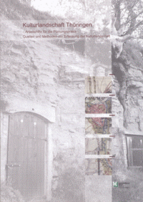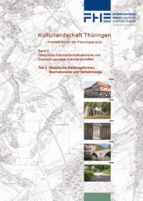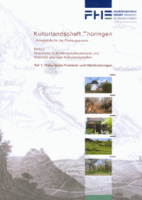Cultural landscape of Thuringia
Almost everywhere in our cultural landscapes, a process of uniformity is taking place that is increasingly making regional typologies disappear leading to a standardization and interchangeability of settlement and landscape images. Against this background, it is necessary to bring the individual characteristics of landscapes back into the planning field of view, to promote them in a contemporary manner and to develop them further, as is also laid out in the European Landscape Convention drawn up by the Council of Europe in 2000.
The uniqueness or type of landscape essentially has two roots: the concrete natural conditions and the regionally specific usage patterns and cultural forms that have shaped the face of the landscape over centuries and in changing forms. While there are numerous written and map sources about the natural conditions are available, there was a lack of planning-oriented, summarized and prepared materials with reference to the cultural landscape evident, which can be used for processing of landscape plans, landscape framework plans or individual projects. The Thuringia cultural landscape project should help to fill these gaps.
The focus of the project is laid on one hand on the preparation of the basics of Thuringian cultural landscape, on the other hand, it introduces planning methods. Extensive source material was evaluated as part of the project, including many archive materials and historical maps. Essential results were abstracted for the state level in overview maps and brief characteristics.
The results of the project were published in four brochures (see publications):
Results




• Volume I "Cultural Landscape of Thuringia. Working aid for planning practice. Sources and methods for recording the cultural landscape & quot; (Schmidt & Meyer et al. 2006). The primarily planning-methodical volume contains on 146 pages an evaluative overview of the sources available for recording the historical development of the cultural landscape (historical maps; pictorial representations such as paintings, drawings, prints, postcards; Thuringian legends and legendary landscapes; literature sources; archive documents). It also contains a mapping key & quot; Thuringia Cultural Landscape & quot; and presents exemplary planning approaches at regional and municipal level. The accompanying CD contains various databases and directories: e.g. a selection bibliography on the cultural landscape of Thuringia with around 1000 titles, overviews of selected archive holdings, pictorial representations and legendary landscapes of Thuringia.
• Volume II, Part 1 "Cultural landscape of Thuringia. Working aid for planning practice - Vol. 2: Historical cultural landscape elements and historical shaped cultural landscapes, Part 1: Historical open land and forest uses" presents on 198 pages and 16 separate map supplements selected historical land uses and cultural landscape elements of the open-air area (field terraces and terrace landscapes, viticulture and historical viticulture landscapes, orchards, historical woad cultivation, medicinal and ornamental plant cultivation, extensively used pasture landscapes, historical forest usages, mills and mill Landscapes, historical mining and mining landscapes, quarries and quarry landscapes, hollow paths and hollow path landscapes). The volume also contains an outline of the Thuringian cultural landscape development from prehistory to the present.
• Volume II, Part 2 "Cultural Landscape of Thuringia. Working aid for planning practice. Historical cultural landscape elements and historically shaped cultural landscapes, part 2: Historical forms of settlement, building materials and traffic routes" on 88 pages and 7 separate maps deals with issues relating to settlement and transport (historical settlement forms and settlement landscapes, historical building materials and natural stone landscapes, historical traffic routes).
• Volume III serves as a “Practical guide to recording historical parts of the cultural landscape (with glossary and register)”. On 40 pages it contains, among other things, a systematic register of cultural landscape elements and a color-illustrated glossary of valuable parts of the cultural landscape.
![]() Kulturlandschaft Thüringen - Arbeitshilfe für die Planungspraxis (link opens extern project website)
Kulturlandschaft Thüringen - Arbeitshilfe für die Planungspraxis (link opens extern project website)
- ANSICHT Kulturlandschaft Bd I.pdfVolume I "Cultural landscape of Thuringia. Working aid for planning practice. Sources and methods for recording the cultural landscape" (Schmidt & Meyer et al. 2006). Text volume. The supplementary database is available on CD.
- ANSICHT Kulturlandschaft Bd II.1.pdfVolume II.1 "Cultural landscape of Thuringia. Historic cultural landscape elements and historically shaped cultural landscapes. Part 1: Historical open land and forest uses" (Meyer et al. 2008). Text volume. The supplementary map section is available on CD.